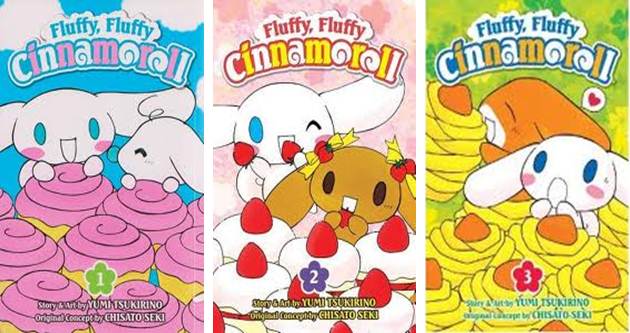Fluffy, Fluffy Cinnamoroll by Y. Tsukirino
DOI:
https://doi.org/10.20361/G2CS34Abstract
Tsukirino, Yumi. Fluffy, Fluffy Cinnamoroll. 3 vols. San Francisco: VIZ Media, 2012. Print.
Reading young children graphic novels is lots of fun and potentially encourages a more adaptable sense of narrative and enhanced visual interpretive skills. Many European and pan-Asian visual narratives test and thrill readers with the unanticipated ways they resolve the challenges of creating cohesive visual narratives and young readers can begin to appreciate narratives that don’t function in familiar, aesthetically normalized ways. The manga Fluffy, Fluffy Cinnamoroll has an appealing, unstructured page design that is enjoyable for young readers to negotiate but its real audience is pre-teens and teenagers who yearn for a big dose of super-kawaii Japanese culture.
Fluffy, Fluffy Cinnamoroll has been given an “A” or “all ages” rating by the publisher and Cinnamoroll, the eponymous fluffy puppy, is part of the empire of Sanrio licensed characters which include Hello Kitty and her cohort of friends. Like Cinnamoroll characters designed for young Japanese readers are generally drawn with simple, “black dot” eyes so it might seem that Fluffy, Fluffy Cinnamoroll should be accessible for children in Grades 2 to 5. The appeal of characters designed for young audiences is not, however, always limited to young audiences and that is where consideration of the readership for which Fluffy, Fluffy Cinnamoroll is intended gets complicated.
Book 1 starts appealingly with an introduction of the characters and magically-themed, short vignettes in which Cinnamoroll and his other puppy friends have adorable and mildly amusing adventures. There is little narrative continuity or intensity and readers must be drawn in by the magnetism of sheer cuteness but effervescent books like Fluffy, Fluffy Cinnamoroll have a legitimate place in a child’s repertoire of reading experiences. The tone and content in Books 1 and 2 are innocuous in the extreme but in Book 3, the tone and content changes. One of the stories has the pups eagerly auditioning to become pop idols. Another centres on the rigorous diet and exercise that some of puppies have to commit to in order to be ready for “bikini season”. It seems as though the writer has shifted tone to write for her own demographic rather than younger children. Book 3 is for an audience that thrills to the cuteness of the puppies but is media literate, relatively sophisticated and perhaps even a little world-weary.
Fluffy, Fluffy Cinnamoroll is fun to read. It is brimming with interesting Japanese cultural context and is at times quite funny in a light and irreverent way. VIZ Media should be commended for bringing a wide range of manga to North American audiences with a slight proviso that, while can be very difficult to establish age-appropriate ratings, Fluffy, Fluffy Cinnamoroll is not quite as uncomplicatedly “all ages” as its “A” rating would indicate.
Recommended with Reservations: 2 out of 4 stars
Reviewer: Matilda Roche

Published
How to Cite
Issue
Section
License
Authors who publish with this journal agree to the following terms:
- Authors retain copyright and grant the journal right of first publication with the work simultaneously licensed under a Creative Commons Attribution License that allows others to share the work with an acknowledgement of the work's authorship and initial publication in this journal.
- Authors are able to enter into separate, additional contractual arrangements for the non-exclusive distribution of the journal's published version of the work (e.g., post it to an institutional repository or publish it in a book), with an acknowledgement of its initial publication in this journal.
- Authors are permitted and encouraged to post their work online (e.g., in institutional repositories or on their website) prior to and during the submission process, as it can lead to productive exchanges, as well as earlier and greater citation of published work (See The Effect of Open Access).






